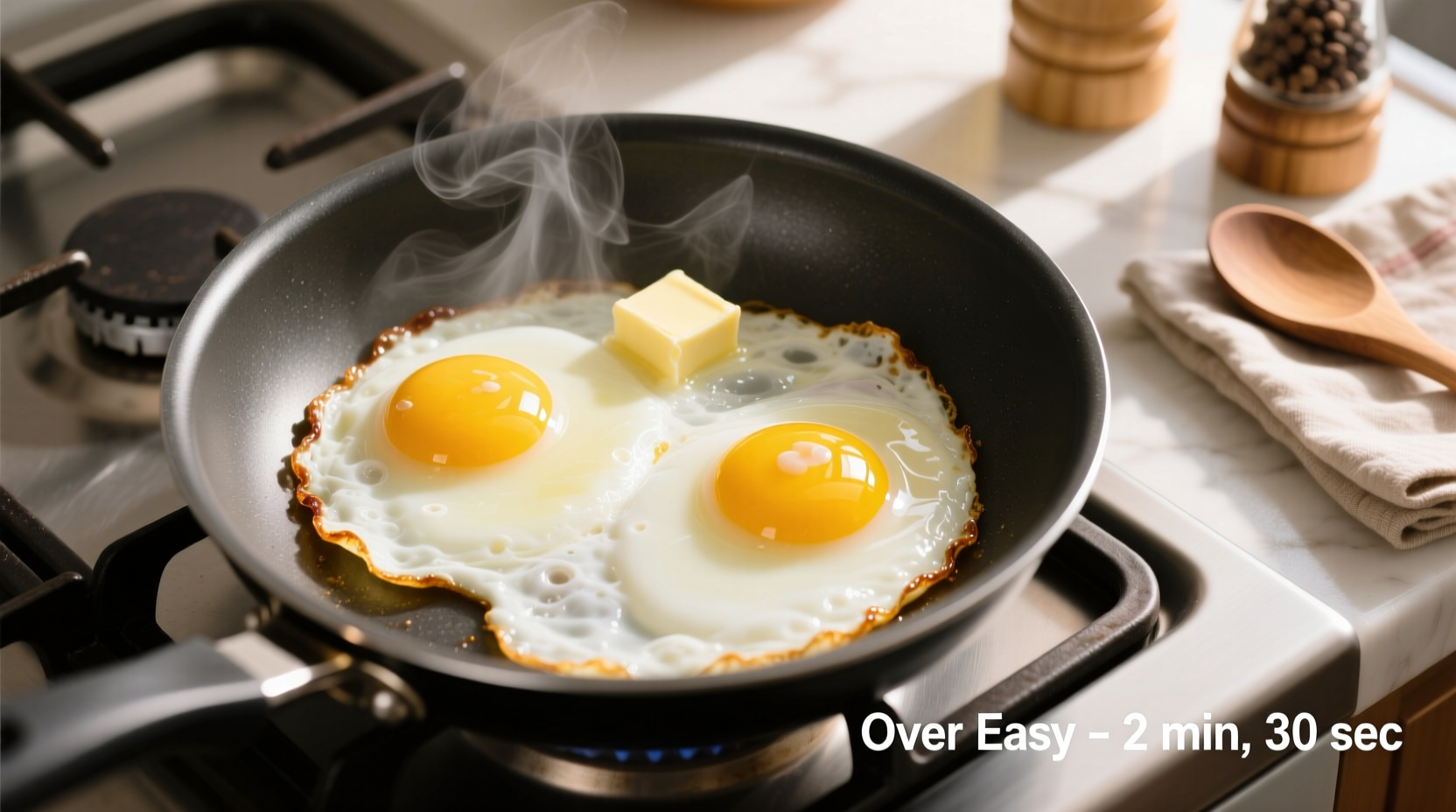What Makes Over Easy Eggs Different
Over easy eggs feature fully set whites with a delightfully runny yolk center. Unlike over medium (partially set yolk) or over hard (fully cooked yolk) preparations, over easy eggs maintain that signature liquid golden center that flows when pierced. This cooking style requires precise timing and temperature control to achieve the perfect balance between set whites and liquid yolk.
| Egg Style | White Texture | Yolk Texture | Cooking Time |
|---|---|---|---|
| Over Easy | Fully set | Completely liquid | 2.5-3 min first side, 30-60 sec second side |
| Over Medium | Fully set | Partially set | 3 min first side, 60-90 sec second side |
| Over Hard | Fully set | Fully cooked | 3 min first side, 2-3 min second side |
Essential Equipment Checklist
Using the right tools makes all the difference in achieving perfect over easy eggs. Professional chefs consistently recommend:
- Non-stick skillet (8-10 inch) - prevents sticking and allows easy flipping
- Silicone or thin metal spatula - provides precise control during flipping
- Fresh eggs (within 1-2 weeks of purchase) - yolks hold shape better
- Butter or oil with high smoke point (avocado, canola)
Step-by-Step Cooking Process
- Preheat your pan over medium-low heat for 2-3 minutes. The ideal temperature range is 275-300°F (135-150°C) - too hot and whites will overcook before flipping, too cool and eggs will stick.
- Add fat - 1 teaspoon of butter or oil. According to USDA food safety guidelines, proper heat management prevents bacterial growth while achieving desired texture. Wait until butter foams slightly but doesn't brown.
- Crack eggs into a small bowl first, then slide gently into the pan. This prevents shell fragments and gives you control over placement. Leave at least 1 inch between eggs if cooking multiple.
- Cook first side for 2-3 minutes until edges turn opaque and whites begin setting. The key indicator is when approximately 75% of the white has turned from clear to opaque.
- The flip technique - Slide spatula completely under the egg, lift slightly to ensure no sticking, then quickly but gently flip in one motion. Cook 30-60 seconds until whites are fully set but yolk remains liquid.

Troubleshooting Common Problems
Even experienced cooks encounter challenges with over easy eggs. Here's how to solve the most frequent issues:
Yolk Breaks During Flipping
Cause: Pan temperature too high or improper flipping technique. Solution: Reduce heat slightly and use a wider spatula that fully supports the egg. Wait until whites are more set before flipping - about 75% opaque.
Whites Stick to the Pan
Cause: Insufficient preheating or inadequate fat. Solution: Ensure proper preheating time and use enough butter or oil. Non-stick pans require less fat than cast iron, but some is always necessary for proper release.
Yolks Cook Through
Cause: Overcooking second side or pan too hot. Solution: Reduce cooking time on second side to 30-45 seconds. Remember that residual heat continues cooking the egg after removal from pan.
Pro Tips for Consistent Results
- Room temperature eggs cook more evenly than cold eggs from the refrigerator
- Season after flipping - salt before cooking can break down proteins and make whites watery
- Use fresh eggs - yolks from fresh eggs hold their shape better during flipping
- Don't overcrowd the pan - cook no more than 2-3 eggs at a time in a standard skillet
Safety Considerations
While over easy eggs feature a runny yolk, food safety remains important. The USDA recommends cooking eggs until whites are completely set, which occurs during the first side cooking. Though yolks remain liquid, the surrounding cooked whites create a barrier that minimizes food safety risks. For vulnerable populations (pregnant women, elderly, immunocompromised), consider using pasteurized eggs which have been heat-treated to eliminate potential bacteria while maintaining the same cooking properties.
Perfect Pairings for Over Easy Eggs
Over easy eggs complement many breakfast dishes. The runny yolk creates a natural sauce that enhances:
- Toasted English muffins with Canadian bacon (classic eggs Benedict style)
- Breakfast sandwiches with crusty bread
- Breakfast burritos with black beans and avocado
- Hash browns or roasted potatoes
Frequently Asked Questions
How do you know when to flip over easy eggs?
Flip when the egg whites are mostly opaque (about 75% set) but the yolk remains completely liquid. The edges should be firm and the bottom lightly golden. This typically takes 2-3 minutes on medium-low heat.
Can you make over easy eggs without flipping?
Traditional over easy eggs require flipping to cook both sides while maintaining a runny yolk. Some chefs use a technique called "basting" where they spoon hot oil over the top, but this creates a different texture than the classic flipped version.
Why do my over easy eggs always stick to the pan?
Eggs stick when the pan isn't properly preheated, there's insufficient fat, or you try to move the egg too soon. Ensure your non-stick pan is heated for 2-3 minutes before adding 1 tsp of butter or oil, and wait until the whites are mostly set before attempting to flip.
How long do over easy eggs take to cook?
Total cooking time is typically 3-4 minutes: 2-3 minutes for the first side until whites are mostly set, followed by 30-60 seconds for the second side after flipping. Cooking time varies based on pan type, heat level, and egg freshness.











 浙公网安备
33010002000092号
浙公网安备
33010002000092号 浙B2-20120091-4
浙B2-20120091-4